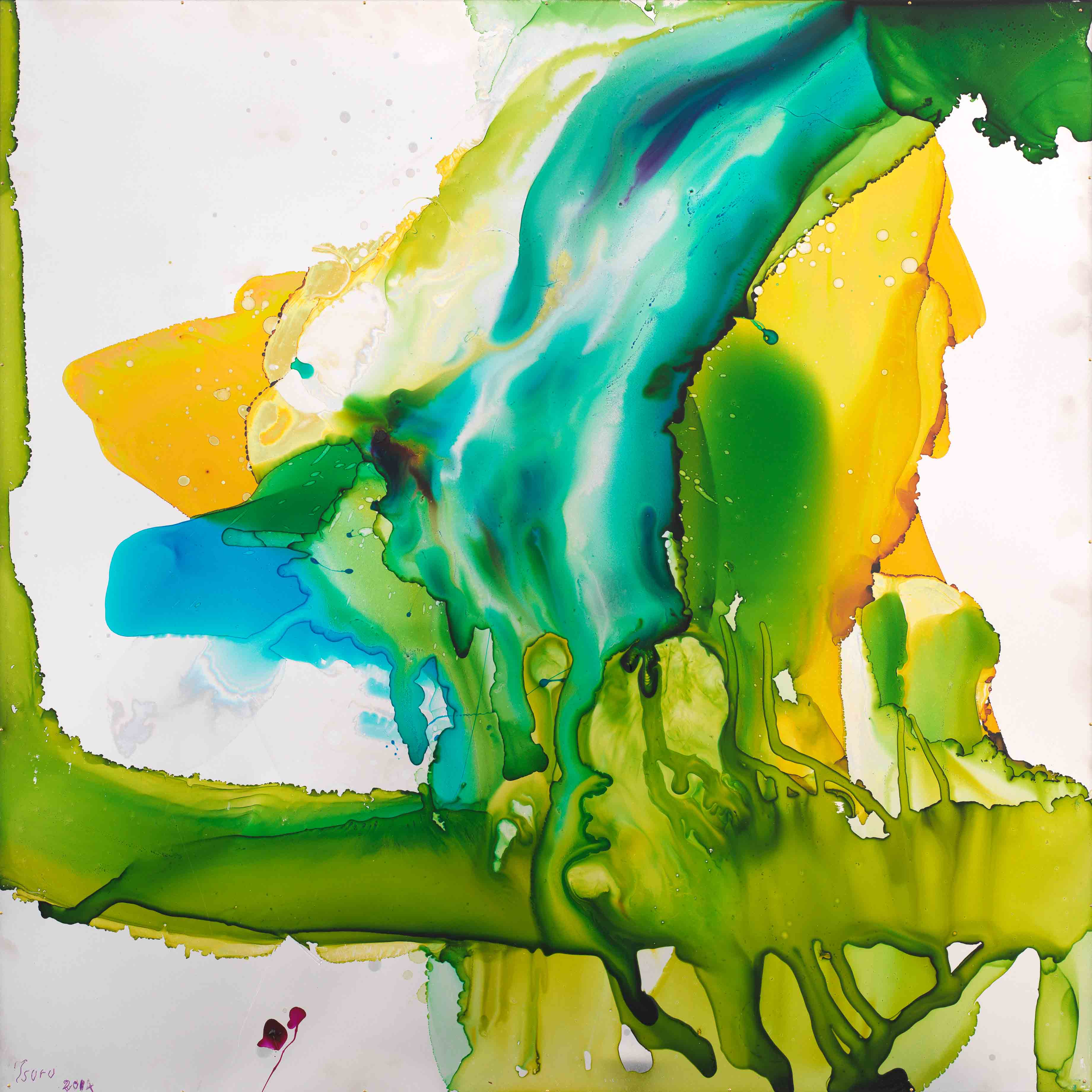93 × 93 cm
framed 95 × 95 × 3.5 cm
Courtesy of LADS Gallery, Osaka, and Take Ninagawa, Tokyo
Yamazaki Tsuruko (1925 – 2019) was a founding member of the Post World War II Gutai Art Association (1954 – 1972) and experimented with newly available materials and effects. She was the only female member who stayed with the group during its entire existence.
As an abstract painter and sculptor, she was inspired by readily available and found material and explored them and their characteristics. Early in her career she used tin as a support for its reflective qualities, nonabsorbent surfaces on which she applied aniline dye. She cut, bent and shaped it, added colored floor lighting to heighten the effects and particularities of her paintings and create installations. The bold, fluid translucent colors (magenta, green, violet, yellow) on this surface seem to float and be in a continued state of motion. Yamazaki allows movement and weightlessness to flow on and emanate from the surface of a painting.
Red Cube, 1956, created for the 1956 Gutai Outdoor Art Exhibition enticed passersby to enter the suspended vinyl space by bending down and stand in the illuminated glow of color and see their shadows on the ground and the vertical panels. The merger of color and shiny synthetic material in an outdoor semi-open structure allows for playfulness and experimentation.
Tin Cans, (1955/1986) were made by applying an aniline dye on large sheets of tin, cutting them up and shaping individual cans. The various hues of purplish pink and markings depend on the individual application. The relationship to canned food available at the time, the act of painting or varnishing a can approximately the size of a household paint can is characteristic of her combination of material, challenging the expected use and properties of reflection and communication. A selection of them were presented at the 2009 Venice Biennale, Fare Mondi // Making Worlds, curated by Daniel Birnbaum.
Unafraid of color and space, over six decades her paintings could incorporate thick bold diagonal lines, pop art motifs, enlarged colored bubbles, futuristic motifs and pachinko inspired patterns. The 2013 painting, Work, is representative of her style since 2000s, using the tin, dye and thinner she learned to master in the 1950s. The greens, yellow, turquoise, white and negative space share the smooth square surface and structure in harmony yet the allusion of movement is punctuated by small round bubbles and two deep red marks.
She introduced flexibility, humor and her extraverted personality and style into her artworks and installations
Her paintings and sculptures are included in the museum collections of Instituto Inhotim, Belo Horizonte, BR; M+ Hong Kong, HK;; Ashiya City Museum of Art and History, Ashiya; Hyogo Prefectural Museum of Modern Art, Kobe; Miyagi Museum of Art, Sendai; Osaka City Museum of Modern Art, Osaka; Takamatsu Museum of Art; Takamatsu; The National Museum of Art, Osaka; 21st Century Museum of Art, Kanazawa, JP; Dallas Museum of Art, Dallas, TX; Hirshhorn Museum and Sculpture Garden, Washington D.C.; Museum of Modern Art, New York, NY; The Art Institute of Chicago, Chicago, IL, US; Guggenheim Abu Dhabi, Abu Dhabi, AE and various private collections.
She was featured in groundbreaking exhibitions such as the 1958 6th Gutai Art Exhibition at New York’s Martha Jackson Gallery, organized by Michel Tapié, Nul 1965, Stedelijk Museum, Amsterdam, Japon des Avant-Gardes 1910–1970”, Centre Pompidou, Paris (1986); Japanese Art after 1945: Scream Against the Sky, curated by Alexandra Munroe, Yokohama Museum of Art, Japan, the Guggenheim SoHo, New York, and the San Francisco Museum of Modern Art (1994–95). She participated along with other Gutai members in the Forty-Fifth (1993) and Fifty-Third (2009) Venice Biennales. Major recent Gutai retrospectives at the National Art Center, Tokyo, JP Gutai : The Spirit of an Era in 2012 and in 2013, Gutai : Splendid Playground, at the Solomon R. Guggenheim Museum, New York, US.
Anne Mosseri-Marlio
